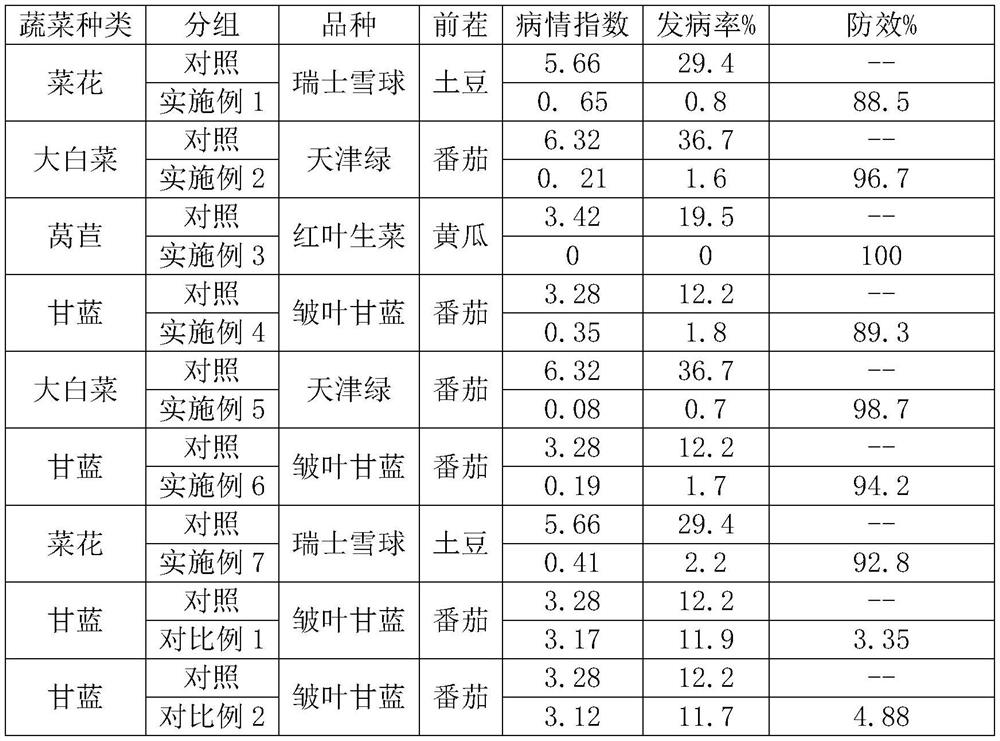Preparation method and application of a substrate for preventing and treating vegetable soft rot
A technology for soft rot and vegetables, which is applied to the preparation of a substrate for preventing and controlling vegetable soft rot, the application of a substrate for preventing and controlling vegetable soft rot, and the field of preventing and controlling vegetable soft rot, and can solve the problem of unsatisfactory control effect, drug resistance and control effect. problems such as poor quality, to achieve the effect of simple and economical preparation method, strong inhibitory effect, and avoidance of dissemination
- Summary
- Abstract
- Description
- Claims
- Application Information
AI Technical Summary
Problems solved by technology
Method used
Image
Examples
Embodiment 1
[0029] A. Weigh 500g of polished round-grained rice, soak it in 500ml of lime water with 1% mass fraction for 4 hours for disinfection, rinse with clear water, pulverize, and pass through a 22-mesh sieve;
[0030] Weigh 500g of corn, sterilize by soaking in 500ml of 1% lime water for 4 hours, rinse with water, crush, and pass through a 25-mesh sieve;
[0031] B. Japonica rice fermentation product: the sieved japonica rice is mixed with 50ml of water as the japonica rice medium, and inoculated according to 1g japonica rice medium for 10 6 A spore of Monascus purpura was inoculated, and fermented naturally at 28°C for 6 days to obtain a japonica rice fermentation product;
[0032] Fermented corn product: add 50ml of water to the sieved corn and mix it as a corn culture medium, inoculate 10 8 Oryzae spores were inoculated, and fermented naturally at 30°C for 6 days to obtain corn fermentation products;
[0033] C. The fermented product of corn and the fermented japonica rice ar...
Embodiment 2
[0036] A. Weigh 500g of polished round-grained rice, soak it in 500ml of 1% lime water for 4 hours for disinfection, rinse with clear water, pulverize, and pass through a 15-mesh sieve;
[0037] Weigh 500g of corn, soak it in 500ml of 1% lime water for 4 hours for disinfection, rinse with water, crush it, and pass through a 15-mesh sieve;
[0038] B. Japonica rice fermentation product: the sieved japonica rice is mixed with 50ml of water as the japonica rice medium, and inoculated according to 1g japonica rice medium for 10 5 spores of Monascus purple were inoculated, and fermented naturally at 28°C for 15 days to obtain the japonica rice fermentation product;
[0039] Fermented corn product: add 50ml of water to the sieved corn and mix it as a corn culture medium, inoculate 10 5 Oryzae spores were inoculated, and fermented naturally at 30°C for 15 days to obtain corn fermentation products;
[0040] C. The fermented product of corn and the fermented japonica rice are mixed a...
Embodiment 3
[0043] A. Weigh 500g of polished round-grained rice, soak it in 500ml of 1% sodium bicarbonate aqueous solution for 3.5h for disinfection, rinse with clear water, pulverize, and pass through a 25-mesh sieve;
[0044] Weigh 500g of corn, soak in 500ml of 1% sodium bicarbonate aqueous solution for 3.5h for disinfection, rinse with water, crush, and pass through a 25-mesh sieve;
[0045] B, japonica rice fermentation product: the japonica rice after sieving is mixed with 60ml of water as the japonica rice medium, and inoculated according to 1g japonica rice medium for 10 6 A spore of Monascus purpura was inoculated, and fermented naturally at 30°C for 8 days to obtain a japonica rice fermentation product;
[0046] Fermented corn product: add 60ml of water to the sieved corn and mix it as a corn culture medium, inoculate 10 6 Oryzae spores were inoculated and naturally fermented at 25°C for 8 days to obtain corn fermentation products;
[0047] C. Mix corn fermented products and ja...
PUM
 Login to View More
Login to View More Abstract
Description
Claims
Application Information
 Login to View More
Login to View More - R&D
- Intellectual Property
- Life Sciences
- Materials
- Tech Scout
- Unparalleled Data Quality
- Higher Quality Content
- 60% Fewer Hallucinations
Browse by: Latest US Patents, China's latest patents, Technical Efficacy Thesaurus, Application Domain, Technology Topic, Popular Technical Reports.
© 2025 PatSnap. All rights reserved.Legal|Privacy policy|Modern Slavery Act Transparency Statement|Sitemap|About US| Contact US: help@patsnap.com



